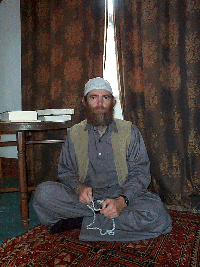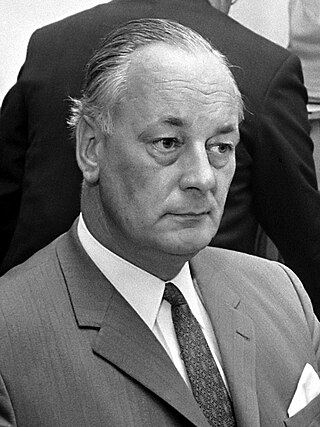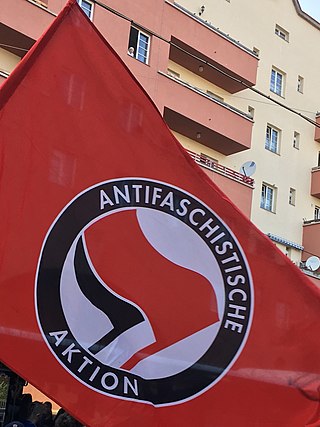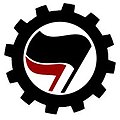
The Homeland, previously known as the National Democratic Party of Germany, is a far-right Neo-Nazi and ultranationalist political party in Germany.

Strasserism is a strand of Nazism, which adheres to revolutionary nationalism combined with anti-capitalism and economic antisemitism. It calls for a more radical, mass-action and worker-based movement in order to implement "anti-capitalist social revolution" along with "national revolution". Strasserism derived its name from Gregor and Otto Strasser, two brothers initially associated with this position. Originally leading a left-wing faction within NSDAP, Otto Strasser created Black Front after being expelled from Germany in 1930. Strasserism allegedly had a considerable support among SA, which led to Strasserists being purged by Adolf Hitler during the Night of the Long Knives, with Gregor Strasser being murdered. In 1980s, Strasserism again began to play an active role in politics after it found support among some leading members of the National Front party in the UK.

David Wulstan Myatt, also known by the pseudonym Abdulaziz ibn Myatt al-Qari, is a British author, religious leader, far-right and former Islamist militant, most notable for allegedly being the political and religious leader of the White nationalist theistic Satanist organization Order of Nine Angles (ONA) from 1974 onwards. He is also the founder of Numinous Way and a former Muslim.
The Third Position is a set of neo-fascist political ideologies that were first described in Western Europe following the Second World War. Developed in the context of the Cold War, it developed its name through the claim that it represented a third position between the capitalism of the Western Bloc and the communism of the Eastern Bloc.

Bases Autónomas was a Spanish neo-Nazi group, later moving to France, and known for its youthful membership and its violent rhetoric and propaganda.

Adolf von Thadden was a German far-right politician. Born into a leading Pomeranian landowning family, he was the half-brother of Elisabeth von Thadden, a prominent critic of the Nazis who was executed by the Nazi government in September 1944.
The far right in Switzerland was established in the course of the rise of fascism in Europe in the interwar period. It was a mostly marginal phenomenon in the Cold War period, excepting a surge of radical right-wing populism during the early 1970s, and it has again experienced growth alongside the right-wing Swiss People's Party since the 1990s.
The far-right in Germany slowly reorganised itself after the fall of Nazi Germany and the dissolution of the Nazi Party in 1945. Denazification was carried out in Germany from 1945 to 1949 by the Allied forces of World War II, with an attempt of eliminating Nazism from the country. However, various far-right parties emerged in the post-war period, with varying success. Most parties only lasted a few years before either dissolving or being banned, and explicitly far-right parties have never gained seats in the Bundestag post-WWII.
Anton Maegerle is the Pseudonym of a German journalist. He is also the author of books about far-right politics, right-wing radicalism, the New Right, and right-wing policy in general.

The Pro Germany Citizens' Movement was a far-right political party in Germany. It was founded in Cologne on 20 January 2005 after Pro Cologne members had been elected to the Cologne City Council. Manfred Rouhs, treasurer of the Pro Cologne movement and former candidate of the German League for People and Homeland and the National Democratic Party of Germany, was elected its first chairman. The federal party convent decided at its ninth ordinary meeting in Wuppertal on 11 November 2017 to dissolve the party.

The Identitarian movement or Identitarianism is a pan-European, ethno-nationalist, far-right political ideology asserting the right of European ethnic groups and white peoples to Western culture and territories claimed to belong exclusively to them. Originating in France as Les Identitaires, with its youth wing Generation Identity, the movement expanded to other European countries during the early 21st century. Its ideology was formulated from the 1960s onward by essayists such as Alain de Benoist, Dominique Venner, Guillaume Faye and Renaud Camus, who are considered the main ideological sources of the movement.

Anti-fascism is a political movement in opposition to fascist ideologies, groups and individuals. Beginning in European countries in the 1920s, it was at its most significant shortly before and during World War II, where the Axis powers were opposed by many countries forming the Allies of World War II and dozens of resistance movements worldwide. Anti-fascism has been an element of movements across the political spectrum and holding many different political positions such as anarchism, communism, pacifism, republicanism, social democracy, socialism and syndicalism as well as centrist, conservative, liberal and nationalist viewpoints.
Nipster is a slang term used in Germany and the U.K. to refer to young neo-Nazis who have embraced aspects of hipster culture. Historically, German neo-Nazis promoted an ultra-masculine and extreme right-wing image, preferring short hair, violent imagery and combat gear—in keeping with the white power skinhead or casual subcultures—while rejecting most modern pop culture. This has changed, with young "nipsters" embracing causes such as animal rights and environmentalism alongside historically far right positions, including anti-immigration views. Nipsters, rather than rejecting modern pop culture, seek instead to appropriate it to promote neo-Nazi ideals. This has also been seen in the New Right and National Anarchism movements.
Werner Bergmann is a German sociologist. He is Professor of Sociology at the Center for Research on Antisemitism at the Technical University of Berlin.

Götz Kubitschek is a German publisher, journalist and far-right political activist. He espouses ethnocentric positions and is one of the most important protagonists of the Neue Rechte in Germany. Hailing from the staff of right-wing newspaper Junge Freiheit, Kubitschek is one of the founders of the Neue Rechte think tank Institut für Staatspolitik. Since 2002, he is the manager of his self-founded publishing house Antaios, since 2003 chief editor of the journal Sezession, as well as editor of the corresponding blog Sezession im Netz.
Far-right subcultures refers to the symbolism, ideology and traits that hold relevance to various politically extreme right-wing groups and organisations. There are three kinds of subcultures within far-right movements to distinguish: subcultural parasitism, subcultural creation around ideology and subcultures that are networking with far-right movements, as some football hooligans did with neo-nazis.

Post–World War II anti-fascism, including antifa groups, anti-fascist movements and anti-fascist action networks, saw the development of political movements describing themselves as anti-fascist and in opposition to fascism. Those movements have been active in several countries in the aftermath of World War II during the second half of the 20th and early 21st century.
Antifa is a political movement in Germany composed of multiple far-left, autonomous, militant groups and individuals who describe themselves as anti-fascist. According to the German Federal Office for the Protection of the Constitution and the Federal Agency for Civic Education, the use of the epithet fascist against opponents and the view of capitalism as a form of fascism are central to the movement. The antifa movement has existed in different eras and incarnations, dating back to Antifaschistische Aktion, from which the moniker antifa came. It was set up by the then-Stalinist Communist Party of Germany (KPD) during the late history of the Weimar Republic. After the forced dissolution in the wake of Machtergreifung in 1933, the movement went underground. In the postwar era, Antifaschistische Aktion inspired a variety of different movements, groups and individuals in Germany as well as other countries which widely adopted variants of its aesthetics and some of its tactics. Known as the wider antifa movement, the contemporary antifa groups have no direct organisational connection to Antifaschistische Aktion.

Querfront is a German term originating in Weimar politics and referring to the cooperation between the far-right and far-left, or nationalist and socialist ideologies, as well as the combination of their positions. It is primarily understood as a strategy to unite forces in an effort to gain power. The term was first, and most prominently, used in the Weimar Republic, where it referred to the cooperation between conservative revolutionaries and the far-left.


















